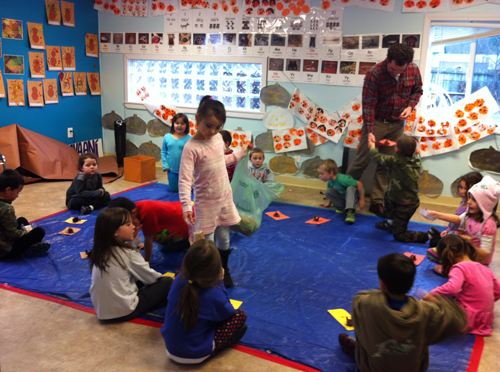
Tristan Guevin helps Kindergarteners with an art project in a classroom at the Sitka Native Education Program (SNEP). He has served as an interim director, deputy director, and programming coordinator while at SNEP, where he specialized in curriculum development and community partnership development. (Photo by Anne Brice/KCAW)
The Sitka Tribe of Alaska brought on two new deputy general managers: Tristan Guevin and Thomas Gubatayao. Work started at the beginning of February, but they will be formally introduced at a regular Tribal Council Meeting at 6:30 pm on Wednesday, Mar. 20 in the Sheet’ka Kwáan Naa Kahídi Community House on 200 Katlian Street.
Listen to iFriendly audio.
Guevin has been with STA since 2009. He began working with the Tribe on a federally funded Tlingit language revitalization project. It was a partnership between the Sitka Tribe of Alaska and the Sitka Native Education Program, or SNEP.
Guevin will help oversee the Cultural Resources, Education and Employment, and Social Services programs for the tribe. He is the deputy director of SNEP and says in his new position, one of his goals is to open a tribally run preschool.
“It’s really about connecting our students with the past, with their ancestry. It’s about both the past and moving forward and really giving our students a sense of pride in who they are and carry on that tradition.”
He says revitalizing the Tlingit language preserves the worldview of the area’s earliest known inhabitants.
“There’s a quote that Das dee Ah always says: Everything has the Tlingit language in it. All things living. All things around them. That’s the Tlingit way of life. For me, the language for me is almost a window into a people’s soul. Into the way that they see the world.”
Guevin says the only way they can be successful is through inter-generational learning. One of the cornerstone programs is a summer harvesting program. Kids harvest natural resources — berries and cedar and spruce root
“But it’s about more. it’s about harvesting from one another. it’s about students harvesting the knowledge from the elders. and vice versa. the elders harvesting the knowledge from the students. There’s no definition of who the student is, who the teacher is, that we’re really working together to share knowledge.”































